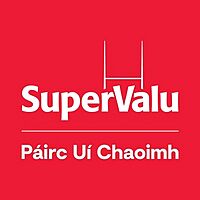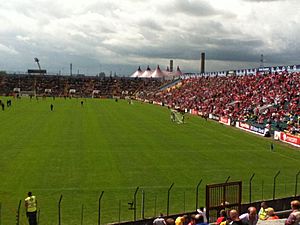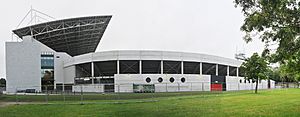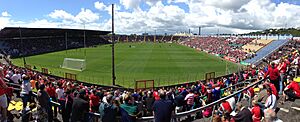Páirc Uí Chaoimh facts for kids
|
De Park
|
|
 |
|

Stadium exterior
|
|
| Address | The Marina Ballintemple Cork Ireland |
|---|---|
| Coordinates | 51°53′59.10″N 8°26′6.15″W / 51.8997500°N 8.4350417°W |
| Owner | Cork County Board |
| Capacity | 45,300 |
| Field size | 144 m x 88 m |
| Construction | |
| Broke ground | April 1974 |
| Opened | 6 June 1976 |
| Renovated | 2008 2015–2017 |
| Construction cost | IR£1.7 million (original) €110 million (redevelopment) |
| Architect | Horgan and Lynch (1974) Scott Tallon Walker (2015) |
| Tenants | |
| Cork GAA (1976–present) | |
Páirc Uí Chaoimh (say "Park ee Kheev") is a famous stadium in Cork, Ireland. People often call it "The Park." It is the main home for Cork GAA teams. The stadium is in Ballintemple, where an older sports ground used to be.
In February 2024, the stadium got a new name: SuperValu Páirc Uí Chaoimh. This happened because of a deal with the company SuperValu. The stadium first opened in 1976. It then had a big upgrade between 2015 and 2017.
This stadium is mostly used for Gaelic games, like Gaelic football and hurling. Cork's home games and championship finals are often played here. Sometimes, with special permission, soccer and rugby games are also held at the stadium.
Many famous music stars have played concerts here. These include Michael Jackson, Bruce Springsteen, Prince, U2, The Stone Roses, Oasis, Elton John, Ed Sheeran, and Westlife. The stadium also hosted a yearly festival called Siamsa Cois Laoi.
When it first opened, the stadium could hold over 50,000 people. Over time, for safety reasons, this number was lowered. After the big upgrade in 2017, the stadium can now hold 45,000 fans. This makes it one of the largest Gaelic games stadiums in Ireland.
History of the Stadium
Early Sports Ground
Long before Páirc Uí Chaoimh was built, people played sports in this area. By the late 1890s, the Gaelic Athletic Association (GAA) in Cork got permission to use part of the land. They built their own stadium there in 1898. This old stadium was called the Cork Athletic Grounds. It hosted many important games, including All-Ireland and Munster finals.
By the 1960s, the old Athletic Grounds were not modern enough. The facilities were quite basic. So, in 1963, the Cork County Board bought land on the other side of the city for a new stadium. This new plan did not work out, so they looked for another solution.
Building the New Stadium
In 1972, the GAA decided to rebuild the Athletic Grounds instead. They bought more land nearby. The new stadium project started in April 1974. It was designed to be very modern. The building cost about £1.7 million.
The stadium was named Páirc Uí Chaoimh to remember Pádraig Ó Caoimh. He was a very important person in the GAA. The new stadium was planned to hold over 50,000 people. It had seats for nearly 20,000 fans, with half of them covered.
Official Opening Day
Páirc Uí Chaoimh officially opened on June 6, 1976. Con Murphy, who was the president of the GAA at the time, opened it. On that special day, the Cork hurlers played against Kilkenny. The Cork footballers also played against Kerry.
Concerts and Events
To help pay for the stadium, a music festival called Siamsa Cois Laoi (which means "Fun by the River Lee") was started. It ran every year from 1977 to 1987. Many international and Irish music stars performed there.
In August 1987, U2 played a huge concert at the stadium. This showed that the venue was great for big pop and rock shows. In July 1988, Michael Jackson performed two concerts with over 130,000 people attending. Prince also played his first Irish concert here in 1990. Other big names like Oasis and Bruce Springsteen have also performed.
After the stadium's big upgrade, Ed Sheeran played the first concerts in May 2018. He returned again in April 2023. Elton John also performed here in July 2022.
Stadium Improvements
In 2005, all the old wooden seats were replaced with new plastic seats. There were also plans in 2007 to make Páirc Uí Chaoimh even bigger, holding 60,000 people. However, these plans did not go ahead.
Soccer and Rugby Games
On September 25, 2018, the stadium hosted its first ever soccer match. It was a special game to remember Liam Miller, an Irish soccer player from Cork who had passed away. A team of Manchester United legends played against a team of Irish and Celtic legends. Over 42,000 fans came to watch.
In April 2024, the Irish women's national football team played France here. Cork player Denise O'Sullivan scored the first international goal at the stadium.
Páirc Uí Chaoimh also hosted its first rugby match on November 10, 2022. Munster played against South Africa A. A record 41,400 people watched the game, which was the most for a rugby match in Munster. In February 2024, Munster also played against the Crusaders from New Zealand.
New Sponsorship Name
In early 2024, the stadium's name changed to SuperValu Páirc Uí Chaoimh. This was part of a sponsorship deal with the SuperValu company. The new name was approved on February 1, 2024.
Stadium Redevelopment
Plans for a Modern Stadium
In 2010, there were plans to give Páirc Uí Chaoimh a major upgrade. The idea was to build a new "Centre of Excellence" with an all-weather pitch, floodlights, and new facilities. A museum and a large car park were also planned.
The new stadium was designed to hold 45,000 people. Some local people were worried about the land being used for the stadium instead of a public park. There were also questions about whether such a big stadium was really needed.
Building the New Páirc Uí Chaoimh
In April 2014, the Cork County Board got permission to start the redevelopment. The Irish Government also gave a grant of €30 million to help fund the project.
The old stadium hosted its last big games in July 2014. The 2014 Munster Senior Football Championship Final and the 2014 Munster Senior Hurling Championship Final were played there. Demolition work began in January 2015. The building work continued until mid-2017.
Reopening the Stadium
The redeveloped stadium was supposed to host the 2017 Munster finals. But construction delays meant these games had to be moved. The very first match in the new stadium was a local hurling game on July 19, 2017. Over 10,000 people came to watch.
Later in July 2017, the stadium hosted two All-Ireland hurling quarter-finals. More than 64,000 fans attended these games. The first championship match saw Tipperary beat Clare. Tony Kelly scored the first point, and Aaron Cunningham scored the first goal in the new stadium.
The redevelopment cost about €110 million. The new stadium has two covered stands and two open terraces. It also has modern dressing rooms, physio rooms, and first aid facilities.
Capacity and Records
After the 2017 upgrade, the main south stand has 13,000 seats. The north stand has 8,000 seats. The two terraces, called the "Blackrock end" and the "City end," each hold 12,000 people. This brings the total capacity to 45,000.
The most people ever to attend a game at Páirc Uí Chaoimh was 49,961. This was for the 1985 Munster Hurling Final between Cork and Tipperary.
See also
- List of Gaelic Athletic Association stadiums
- List of stadiums in Ireland by capacity




